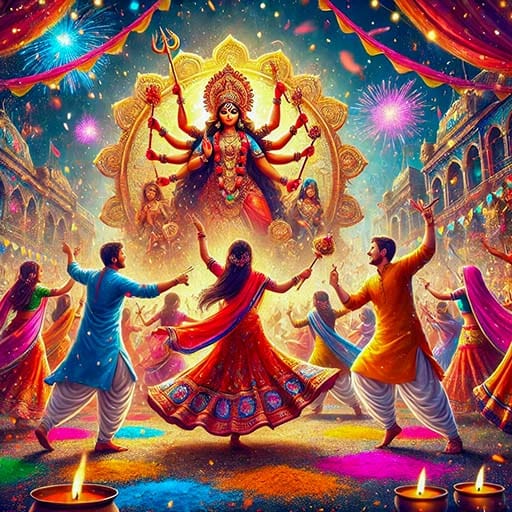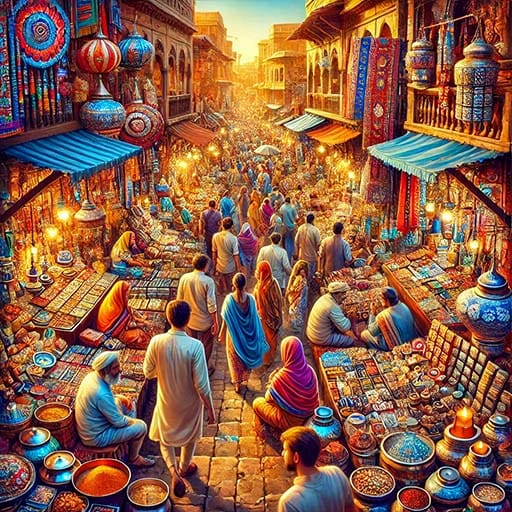India’s vibrant culture truly comes alive through its festivals, where ancient traditions blend beautifully with modern celebrations. Among the country’s many festivals, Navratri, Diwali, and Holi stand out as some of the most iconic. Each festival brings its own unique charm and cultural significance, inviting everyone—locals and visitors alike—to join in the joy. From colorful displays to energetic dances, delicious foods, and spiritual rituals, these festivals highlight India’s unity in diversity. So, let’s dive in and explore what makes these festivals in India so special.
Navratri: A Nine-Night Celebration of the Divine Feminine
During Navratri, people across India celebrate the goddess Durga and her many forms over nine nights. This festival is celebrated twice yearly, but the autumn Navratri, typically observed around September or October, draws the largest crowds. In particular, the states of Gujarat and West Bengal celebrate Navratri with immense enthusiasm.
How People Celebrate Navratri Festival in India
Throughout Navratri, devotees fast, pray, dance, and sing to honor the goddess. Each night, people gather for Garba and Dandiya dances, especially in Gujarat and Maharashtra. Dressed in vibrant, traditional attire, they dance in circles to the rhythm of drums and folk songs. These dances symbolize devotion and unity, as communities come together to celebrate.
In West Bengal, Navratri transforms into Durga Puja, where locals set up elaborate pandals to house stunning idols of Goddess Durga. The festival concludes with Vijayadashami (Dussehra), symbolizing the victory of good over evil, and celebrating Goddess Durga’s triumph over the demon Mahishasura.
Key Highlights of Navratri Festival in India
- Garba and Dandiya Dances: People dance energetically in traditional attire, adding color and vibrancy to the celebration.
- Durga Puja Pandals: Communities create beautiful displays with artistic idols and intricate decorations.
- Fasting and Prayer: Devotees observe fasts and perform daily prayers, seeking blessings from the goddess.
Diwali: The Festival of Lights
Diwali, also known as the Festival of Lights, is one of the most widely celebrated festivals in India. It commemorates Lord Rama’s return to Ayodhya after defeating the demon king Ravana. Typically falling in October or November, Diwali transforms homes, streets, and public spaces into a dazzling display of lights, diyas (oil lamps), and decorations.
How People Celebrate Diwali Festival in India
The Diwali celebrations last for five days, with each day holding unique traditions. People start by cleaning and decorating their homes with rangoli (colorful floor designs) and lighting diyas to welcome prosperity. On Diwali night, families perform Lakshmi Puja to honor the Goddess of Wealth and seek blessings for prosperity and happiness.
After the puja, families and friends enjoy fireworks and share sweets and gifts with loved ones. Diwali symbolizes the victory of light over darkness, knowledge over ignorance, and good over evil.
Key Highlights of Diwali Festival in India
- Lighting Diyas and Fireworks: Families light diyas and enjoy firecrackers, symbolizing the triumph of light over darkness.
- Lakshmi Puja: Devotees worship the Goddess of Wealth, hoping for blessings of prosperity.
- Gift and Sweet Exchanges: Friends and family exchange sweets and gifts, sharing joy and strengthening bonds.
Holi: The Festival of Colors
Holi brings color, energy, and joy to communities across India. Known as the Festival of Colors, Holi celebrates the arrival of spring and the legend of Prahlad and Holika, symbolizing the triumph of good over evil. This vibrant festival usually takes place in March.
How People Celebrate Holi Festival in India
On the eve of Holi, communities gather around a bonfire, known as Holika Dahan, to perform rituals and pray for the removal of evil forces. The next day, people of all ages come together to throw colored powders, splash water, and dance with friends and family. The joyful atmosphere, combined with laughter and color, makes Holi an unforgettable experience.
In some regions, people add unique traditions to Holi. For example, in Mathura and Vrindavan, where Lord Krishna was born, Holi lasts over a week and includes events like Lathmar Holi (where women playfully “beat” men with sticks) and Phoolon ki Holi (where flowers replace colored powders).
Key Highlights of Holi Festival in India
- Holika Dahan: People gather around a bonfire, symbolizing the destruction of evil forces.
- Playing with Colors: Communities celebrate by throwing colored powders and splashing water, creating a festive and joyous atmosphere.
- Festive Foods: People enjoy special treats like gujiya, bhang thandai, and other sweets, adding flavor and fun to the celebration.
Tips for Experiencing Festivals in India
If you’re planning to join these vibrant festivals in India, here are some helpful tips to make your experience truly memorable:
- Plan Ahead to Experience Festivals in India: Since Diwali and Holi attract many tourists from around the world, it’s best to book accommodations well in advance.
- Respect Traditions of Festivals in India: These festivals hold deep cultural and religious importance, so participate respectfully to show your appreciation.
- Dress Appropriately for Festivals in India: For Navratri and Diwali, wearing traditional attire like saris and kurtas can enhance your experience and help you blend in. For Holi, wear clothes you don’t mind staining, as colors are part of the celebration.
- Embrace the Colors of Holi: Holi celebrates colors, so prepare to join in the fun, but don’t forget to protect your skin and eyes.
Why You Should Experience Festivals in India
Indian festivals go beyond mere celebrations—they provide a unique opportunity to experience the country’s cultural diversity and spirituality. Navratri celebrates devotion to the divine feminine, filling communities with dance, music, and joy. Diwali lights up homes and hearts, symbolizing prosperity, warmth, and unity. Meanwhile, Holi bursts forth in a riot of colors, marking the end of winter and celebrating the victory of good over evil.
By joining these festivals, you’ll gain a deeper appreciation for India’s heritage and traditions. Whether you’re dancing Garba during Navratri, lighting diyas on Diwali, or playing with colors on Holi, each festival connects you to the spirit of India in a unique way.
Conclusion: Celebrate the Spirit of the Festivals in India
The Festivals in India—Navratri, Diwali, and Holi—are extraordinary celebrations that capture the heart of Indian culture. They bring people together, fostering unity, joy, and spirituality. From the devotion and dance of Navratri to the lights and love of Diwali, and the vibrant colors of Holi, each festival offers an unforgettable experience. Whether you’re a local or a visitor, immersing yourself in these festivals will leave you with cherished memories and a deeper connection to India’s rich cultural tapestry.
Frequently Asked Questions about Festivals in India (FAQs)
Q: When is the best time to visit India for festivals?
A: The best times are fall (October-November) for Navratri and Diwali and early spring (March) for Holi.
Q: Are these festivals celebrated all over India?
A: Yes, while each state has unique customs, Navratri, Diwali, and Holi are celebrated nationwide.
Q: What should I wear for these Festivals in India?
A: Traditional attire is ideal for Navratri and Diwali, while old clothes are best for Holi due to the colorful powders.





